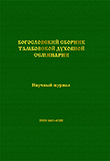Compositional and semantic analysis of the Orthodox rite of the funeral service
DOI:
https://doi.org/10.51216/2687-072X_2023_1_177Keywords:
memorial service, funeral service, categories of “life” and “death”, deceased, commemoration.Abstract
The article considers the logical structure of the Orthodox rite of requiem. The object of the study is the forms of prayers included in the structure of the memorial service used in everyday practice. With the help of structural-semantic analysis, the system of interrelated verbal images in the funeral service is considered, the semantic connections of its compositional parts are revealed. Having considered the history of the formation of rites, the author comes to the conclusion that culture and the basic categories of “life” and “death” are closely interconnected. Understanding the meaning of death in each specific culture is revealed through the realization of the purpose of human life. The Crucifixion and Resurrection of Christ changed the attitude towards life and death. The earthly path of the early Christians was in anticipation of the general resurrection. The article emphasizes that the idea of the Resurrection of Christ (victory over death) is inherent in the entire early Christian culture. Personal death is viewed through the prism of Christ’s death, therefore, the resurrection of all the dead is in the same paradigm. This is the reason for the rather late separation of the memorial service into a separate funeral rite (in the 9th-10th centuries), and the rites acquired their modern form in 1652–1666, under Patriarch Nikon.
Downloads
References
1. Шмеман А., протопресв. Литургия смерти и современная культура / протопресвитер Александр Шмеман. – Москва : Гранат, 2013. – 176 с. – ISBN 978-5-906456-02-1. – Текст : непосредственный.
2. Вендина, Т. И. Базовые категории русской традиционной культуры (жизнь и смерть) / Т. И. Вендина. – Текст : непосредственный // Категории жизни и смерти в славянской культуре : сборник статей. – Москва : Институт славяноведения РАН, 2008. – ISBN 978-5-7575-0223-6. – С. 6–24.
3. Осипов, А.И. Посмертная жизнь души. Из времени – в вечность : беседы современного богослова / А.И.Осипов. – Москва : Данилов мужской монастырь, 2017. – 223 с. : ил. – ISBN 978-5-89101-606-4.–Текст : непосредственный.
4. Афанасий (Сахаров), еп. О поминовении усопших по уставу Православной Церкви / епископ Афанасий (Сахаров). – Санкт-Петербург : САТИСЪ, 1995. – 238 с. – ISBN 5-7373-0080-3. –Текст : непосредственный.
5. Феофан Затворник, свт. Творения иже во святых отца нашего Феофана Затворника. Собрание писем. В 8 вып. Вып. 3/4 / святитель Феофан Затворник. – Москва : Свято-Успенский Псково-Печерский монастырь : Паломник, 1994. – 263 с. – Текст : непосредственный.
6. Нефедов Г., прот. Таинства и обряды Православной Церкви : учеб. пособие по литургике / протоиерей Геннадий Нефедов. – 3-еизд. – Москва : Русский Хронографъ, 2004. – 319 с. – ISBN 5-88060-013-0. – Текст : непосредственный.
7. Коробейникова, Е.А. Развитие заупокойного чина Православной Церкви как одно из направлений духовной деятельности русских композиторов в XIX – начале XX в. : специальность 07.00.02 «Отечественная история» : автореферат диссертации на соискание ученой степени кандидата исторических наук / Коробейникова Екатерина Анатольевна; Южно-Уральский государственный университет. – Челябинск, 2004. – 28 с. – URL: https://www.dissercat.com/content/razvitie-zaupokoinogo-china-pravoslavnoi-tserkvi-kak-odnoiz-napravlenii-dukhovnoi-deyatelno (дата обращения: 10.01.2023). – Текст : электронный.
8. Василик, В.В. Происхождение канона : богословие, история, поэтика / В.В.Василик. – Санкт-Петербург : Издательство СанктПетербургского университета, 2006. – 305 с. – ISBN 5-288-04135-0. – Текст : непосредственный.
9. Феофан Начертанный, прп. Сборник канонов о усопших восьми гласов / преподобный Феофан Начертанный, епископ Никейский, исповедник. – Текст : электронный // Азбука веры : православный портал. – URL: https://azbyka.ru/otechnik/Feofan_Nikejskij/sbornikkanonov-o-usopshih-vosmi-glasov/ (дата обращения: 01.09.2022).
10. Типикон : сие есть устав. В 2 ч. Ч. 1. – Санкт-Петербург : Редакционно-издательское объединение, 1992.– 590 с. – Текст : непосредственный.
REFERENCES
1. Schmemann A., Protopresbyter Liturgiya smerti i sovremennaya kul’tura [The Liturgy of death and modern culture]. Moscow, Granat Publ., 2013, 176 p. (In Russian).
2. Vendina T.I. Bazovye kategorii russkoi traditsionnoi kul’tury (zhizn’ i smert’) [Basic categories of Russian traditional culture (life and death)]. Sbornik statei “Kategorii zhizni i smerti v slavyanskoi kul’ture” [Collection of Articles “Categories of Life and Death in Slavic Culture”]. Moscow, Institute of Slavic Studies RAS Publ., 2008, pp. 6–24. (In Russian).
3. Osipov A.I. Posmertnaya zhizn’ dushi. Iz vremeni – v vechnost’: besedy sovremennogo bogoslova [Posthumous life of the soul. From time to eternity: conversations of a modern theologian]. Moscow, Danilov Monastery Publ., 2017, 223 p. (In Russian).
4. Athanasius (Sakharov), Bishop. O pominovenii usopshikh po ustavu Pravoslavnoi Tserkvi [On the commemoration of the dead according to the regulations of the Orthodox Church]. St. Petersburg, SATIS Publ., 1995, 238 p. (In Russian).
5. St. Theophan the Recluse. Tvoreniya izhe vo svyatykh otsa nashego Feofana Zatvornika. Sobranie pisem [Writings like in the saints of our father Theophan the Recluse. Collection of letters]. Moscow, Holy Dormition Pskov-Caves Monastery, Pilgrim Publ., 1994, issues 3/4, 263 p. (In Russian).
6. Nefedov G., Archpriest. Tainstva i obryady Pravoslavnoi Tserkvi [Sacraments and rites of the Orthodox Church]. Moscow, Russian Chronograph Publ., 2004, 319 p. (In Russian).
7. KorobeynikovaE. A. Razvitie zaupokoinogo china Pravoslavnoi Tserkvi kak odno iz napravlenii dukhovnoi deyate’nosti russkikh kompozitorov v XIX – nachale XX v. Aftoref. diss. cand. istor. nouk [The development of the funeral rite of the Orthodox Church as one of the areas of the spiritual activity of Russian composers in the 19th – early 20th centuries. Extended abstract of diss. cand. of hist. sci.]. Chelyabinsk, 2004, 28 p. (In Russian). Available at: https://www.dissercat.com/content/razvitie-zaupokoinogo-china-pravoslavnoitserkvi-kak-odno-iz-napravlenii-dukhovnoi-deyatelno (date of access: 10.01.2023).
8. Vasilik V. V. Proiskhozhdenie kanona: bogoslovie, istoriya, poetika [The origin of the canon: theology, history, poetics]. St.Petersburg, St.Petersburg University Publ., 2006, 305 p. (In Russian).
9. St. Theophan Nachertanny. Sbornik kanonov o usopshikh vos’mi glasov [Collection of Canons on the departed in eight voices]. Pravoslavny Portal “Azbuka Very” [Orthodox Portal “ABC of Faith”]. (In Russian). Available at: https://azbyka.ru/otechnik/Feofan_Nikejskij/sbornik-kanonov-o-usopshih-vosmi-glasov/ (accessed: 01.09.2022).
10. Tipikon: sie est’ ustav [Typicon: these are the regulations]. St.Petersburg, Editorial and Publishing Association Publ., 1992, 590 p. (In Russian).
Downloads
Published
Issue
Section
Categories
License

This work is licensed under a Creative Commons Attribution-ShareAlike 4.0 International License.

